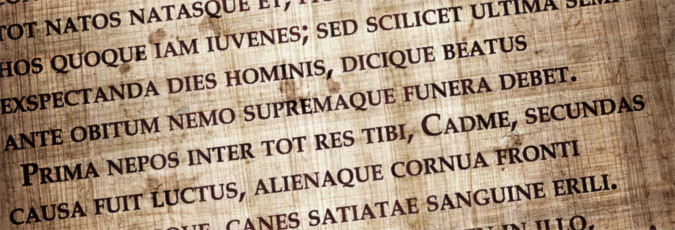Ovid (43 BC-17 AD)
The Roman poet Ovid was born in 43 BC at Sulmo, near Rome. At the age of 50 he was exiled to Tomis on the Black Sea where he died in the year 17 AD. Delacroix imagines what Ovid's exile was like in his painting Ovid among the Scythians.
He is chiefly famed for the 'Metamorphoses', a long verse narrative which retells ancient Greek and Roman legends, unifying them as a sequence and through the theme of the title. The poem, originally written in Latin, was translated and much admired in the Middle Ages; it subsequently provided a rich source of subject matter for artists as diverse as the Pollaiuolo brothers, Titian and Poussin.
Other well-known poems by him include the 'Fasti', which describes the rites of the pagan Roman calendar, and the 'Ars Amatoria' (the 'Art of Love').
Who was Ovid?
Bernadine Corrigan: Ovid was a poet born in 43BC, the year after the assassination of Julius Caesar. He came from a quite wealthy family and as a young man moved to Rome for his education, as was the standard thing at the time. He toured Greece in a mini Grand Tour, which was another thing that wealthy Roman men would have done. Although he took a few jobs in the judiciary, he decided not to go into public life and instead became a poet, and a very successful poet at that.
Very shortly after the 'Metamorphoses' was first published, or perhaps even the first draft was published, we’re not quite sure, Ovid was suddenly exiled from Rome. [Emperor] Augustus made the announcement himself and exiled Ovid to a place called Tomis – in modern-day Romania on the Black Sea – which was frankly a dump.
It was awful. No one went to Tomis, it was right on the edge of the Empire. The climate was terrible, there was no culture there, and Ovid was exiled and his books were banned. We don’t know why this happened. The only evidence we have is what Ovid himself tells us, and he tells us there were two reasons.
There was a carmen and an error. A carmen is a song, a poem, and an error is ... an error, it’s a mistake, an indiscretion. The carmen he’s referring to is [Ovid’s book] the 'Ars Amatoria' ('The Art of Love'), said to induce Roman matrons towards adultery, which of course was rubbish. In fact, it had been published about eight years before he was banished, so that can’t have been the proximate cause.
The error we don’t know, he won’t tell us, but he implies that he has seen something he shouldn’t have seen.
Clearly it is something scandalous to do with the imperial family and over the years everyone has guessed at what that might be. Did he catch one of the imperial family in flagrante delicto, in an adulterous affair. Did he in fact catch Augustus himself having sex with another man?
That theory was very popular in the Middle Ages. Ovid was banned and never ever made it back to Rome. He spent the rest of his life writing letters begging to be allowed back home, and he never was. He died nine years later in Tomis, very sadly.
Metamorphoses
'Metamorphoses' is Ovid's epic poem, almost 900 lines long. A collection of mythical tales based on the theme of 'change', 'Metamorphoses' means 'transformations' in Greek.
The tales of the 'Metamorphoses' were as well known as Bible stories in Titian's day and were a popular source of inspiration for many artists during the Renaissance.
Made up of 15 sections or 'books', each section of 'Metamorphoses' has around six stories. In book two we find the story of Callisto and Arcas which inspired Titian's Diana and Callisto. A favourite nymph of the goddess Diana, Callisto is tricked by Jupiter into betraying Diana, and suffers the consequences.
Titian drew inspiration for two other paintings, Diana and Actaeon and the later The Death of Actaeon, from the story of Actaeon found in the third book. The hunter Actaeon sees something he shouldn't – and like Callisto is also punished.
Read extracts from Ovid's 'Metamorphoses', translated by Ted Hughes

